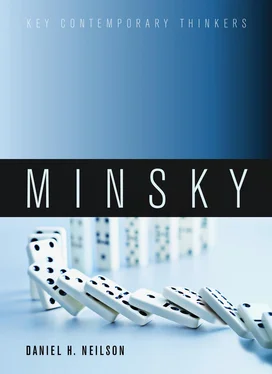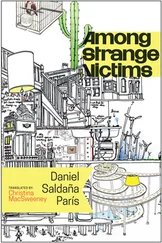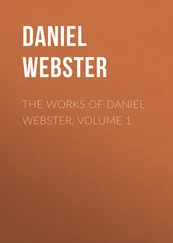Minsky offers not only a theory but also a way of being an economist, which is the subject of the second thread of this book. In sections set in differentiated type, this thread proceeds in parallel with the first. Unlike the theoretical development, which is organized to present the theory coherently, this thread is organized chronologically. It considers, in order, Minsky’s major works (his dissertation, two books, a major research study, an edited volume, and an important series of papers), and in doing so illustrates how Minsky came to know what he knew. This second thread ends with a consideration of contemporary interpretations of Minsky.
The third and final thread takes up the relationship between Minsky’s work and the economics literature. Minsky was a stern critic of many of the main currents of economic and financial theory. He objected to the assumptions that underlie the IS–LM model, in Minsky’s time a major framework for economic analysis and still the main teaching model in undergraduate macroeconomics. Minsky felt that IS–LM lacked a role for realistic financial relationships, which were for him the driving force in an understanding of economic activity. Neither was this critique directed only toward IS–LM: at many turns, Minsky’s focus on finance was the basis for divergence from existing theory.
As a consequence of these objections, Minsky worked at the margins of the economics profession, a topic that runs through his writing from the beginning right to the end. He addressed his colleagues with engagement, despite his frustrations with the trends in assumptions and methodologies of economics that came and went during his time. Rather than rejecting economics entirely, he took refuge among others on the margins. He found allies and an audience there, but they were not spared his criticism either. I have tried to make a constructive contribution without rehashing well-known debates about what is wrong with economics. Minsky, I argue, was trying to express something that is very difficult to express in the language of economics, and this is so for interesting reasons. In chapter 4, I try to be precise about the points of divergence, those specific aspects of Minsky’s financial capitalism that are incompatible with economic theory and practice. I come back to this in chapter 7, where I ask what work has come out of this incompatibility.
In the next section, I introduce the themes of the book in a skeletal form. The section that follows illustrates the disciplinary context in which Minsky worked, for those who might be unfamiliar with economics. The final section of this chapter is a brief reading of the global financial crisis of 2008.
Time, uncertainty, capitalism
Hyman P. Minsky (September 23, 1919–October 24, 1996) began his career as an economist with the completion of his doctoral dissertation at Harvard University in 1954. The experience of the stock market crash of 1929 and the subsequent Great Depression led Minsky, like many of his profession, to the question of whether another large financial disturbance could occur – whether “it” could happen again. Unlike most of his colleagues, he felt compelled to study at first hand the detailed workings of the financial system, the infrastructure of capitalism. This took the form of a study early in his career of the Federal Funds market from a seat in a New York money-market broker, and from 1967 as a consultant to Mark Twain Bank (1957a; Mehrling 1999). 1Minsky concluded that not only could instability recur, but in fact it would necessarily do so, and that such instability was indeed to be expected as a normal part of the functioning of US capitalism.
The crises of the 1960s and 1970s seemed to be powerful evidence in favor of this hypothesis. Much of Minsky’s work on the financial system is written in response to the financial disturbances he observed. His narrative evolves in response to these, but to a significant degree it is the same story each time. The crises that attracted Minsky’s notice were these: the Kennedy Slide of 1962 (1962; 1963a); the 1966 Credit Crunch (1965c; 1968b; 1968c; 1969a; 1969b); the Penn Central liquidity squeeze of 1969–70 (1970a; 1971; 1974a; 1974e); the international monetary crisis of August 1971 (1972a; 1973a); the Franklin National crisis of 1974–5 (1974d; 1976; 1978a; 1978e; 1986e); the 1978 intervention in the exchange value of the dollar (1978f); the silver crisis of 1980 (1980a; 1981b; 1982a; 1983a); the Continental Illinois crisis of 1984 (1984d); and the 1987 financial crisis (1988a; 1988c; 1988d; 1989b; 1992a; 1993a; 1995b). Crisis did, indeed, seem to be normal.
Minsky drew a stark conclusion from these crises, one that was to define his thinking, his career, and his legacy: “[I]n the early 1960s the mode of behavior of the financial system underwent significant changes and … these changes tended to accelerate the trend toward fragile finance” (1975b, 10; also 1995a). Following a stable period between the end of the Depression and the mid-1960s, crisis had become, if not predictable, at least unsurprising. These crises were costly, in terms of unemployment and bankruptcies, and instability seemed to be getting worse, so an investigation was warranted; Minsky’s first-hand observations in financial institutions suggested that that investigation should begin from the financial mechanics.
The acute nature of crisis – headline-making defaults and institutional failures – points to the importance of time in understanding them. Each crisis has a before, in which financial patterns are established and elaborated; a during, when those patterns seem to unravel chaotically and damagingly; and an after, characterized by retrenchment and stability. The cyclicality of crisis, however, seemed also to demonstrate that each post-crisis period becomes, imperceptibly, a pre-crisis period. Minsky saw this temporality embedded in the financial system. “As a result of their debt structure, firms operate today with cash-payment commitments inherited from the past. Furthermore, current investment and ownership of capital assets require financing, which sets up payment commitments for the future” (1982d, 19). Instability, that is, emerges in the present, as promises made in the past are reconciled against an ever-unfolding future.
The unstable present stands between a past that can no longer be changed and a future that cannot yet be fully known. Business ventures into this uncertain future, with entrepreneurs making promises now, to be fulfilled with the eventual proceeds that follow from today’s efforts. It is in the financial system that the success of these ventures will ultimately be tested, when debts made today come due in the future. Time and uncertainty create the possibility for innovation, for the setting in motion of business activity on which capitalism is based. They also, Minsky saw, create the possibility for failure; not just for the failure of a single firm, but for widespread failure due to systemic phenomena. Because the financial system is where past and present meet, it is the locus for crisis.
Minsky thus took as his object of study the capitalist system, with the financial system at its center (1967a). Pervasive uncertainty meant that finance, and thus capitalism, would be constantly subjected to the possibility of crisis. The series of crises over the course of Minsky’s career seemed to provide clear evidence that the US financial system was indeed unstable, and that that instability even arose out of the normal operation of the system. He went so far as to call financial capitalism “inherently flawed” (1969a, 224): “The flaw in American capitalism centers around the financial system, and the financial system is an essential attribute of the economy” (1968a, 578).
The ramifications of time and uncertainty are written into the financial system; the resulting instability of capitalism constitutes its inherent flaw (1996). The investigation of this problem set Minsky in motion, and sustained his entire career. There seemed to be plenty to talk about, and one might suppose that Minsky’s contributions would have found an attentive audience among his fellow economists.
Читать дальше












